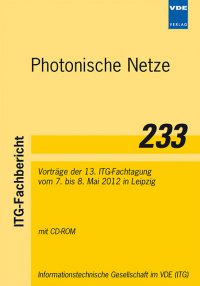Spectral Network Efficiency Evaluation of Optical Networks with Software Defined Optics and Flexible WDM Grid Variants
Konferenz: Photonische Netze - 13. ITG-Fachtagung
07.05.2012 - 08.05.2012 in Leipzig, Germany
Tagungsband: Photonische Netze
Seiten: 6Sprache: EnglischTyp: PDF
Persönliche VDE-Mitglieder erhalten auf diesen Artikel 10% Rabatt
Autoren:
Autenrieth, A.; Elbers, J.-P.; Grießer, Helmut; Grobe, Klaus (ADVA AG Optical Networking – Advanced Technology, Fraunhoferstr. 9a, 82152 Martinsried, Germany)
Eiselt, Michael (ADVA AG Optical Networking – Advanced Technology, Maerzenquelle 1-3, 98617 Meiningen, Germany)
Inhalt:
Key enabling technologies of next-generation optical networks comprise a fully programmable opticaltransport layer using software-defined optical transceivers with variable data rate, number of subcarriers, symbol rate, and spectral bandwidth. The underlying WDM layer is using a flexible frequency grid, which is currently being standardized by ITU-T. In this paper, we investigate the impact of flexible WDM grid with different grid spacing, line rate, and spectral signal bandwidth combinations on the overall spectral network efficiency. Recent publications on spectral assignment performance evaluation with flexible WDM grid are addressing highly dynamic optical networks with varying network load given in Erlang and use blocking probability as performance parameter. However, typical optical networks will have a more static operation with very long holding times of optical connections. Therefore, in this paper we evaluate the spectral assignment algorithms for incremental network design supporting fiber overbuild to solve wavelength/spectrum blocking. Various combinations of data rates, symbol rates, subcarriers, modulation schemes, and spectral bandwidth are taken into consideration, and the resulting optical reach is calculated with reference to a state-ofthe- art coherent 100-Gbit/s transceiver with DP-QPSK modulation. The various signal combinations are evaluated on reference network architectures with different WDM grid spacing, and compared using the allocated spectrum as well as unused or stranded spectrum as performance indices.


